Fanttik’s first portable power station is the EVO 300, and I wanted to see if it could compete with the other 300Wh models on the market today.
I tested every aspect of the power station except for its use in the rain. I also used Fanttik’s 100W solar panel to complete the solar generator setup and tested it out alongside the EVO 300.
Below are my results from testing, starting with the pros and cons of the EVO 300.
| Pros | Cons |
|---|---|
| 1. Can take in up to 120W from solar panels | 1. Battery cycle life is not stated |
| 2. Has one of the largest LCD screens on the market | 2. Slightly heavier than Jackery 300 & Rockpals 300 |
| 3. Has nine output ports including regulated 12V ports | 3. AC charger rated for 90W, but the input port is capable of 120W |
The Fanttik EVO 300 recharges fast, has practical output ports, and is nearly silent during use. However, its battery cycle life isn’t listed, which is crucial for estimating lifetime value. Still, I recommend this power station with its 100W solar panel due to their impressive features.
Below is my scoring breakdown of the EVO 300 power station. Later on, I will be going over the EVO Solar 100 solar panel in detail.
| Category Analyzed | Max’s Score | Comments |
|---|---|---|
| Battery Lifecycles | 5/10 | Unknown cycle life, but has a lithium-ion battery (typically 500 cycles to 80% capacity) |
| Output Port Options | 10/10 | Nine total ports, including a 60W USB-C PD and regulated 12V ports |
| Recharging Times | 7/10 | Relatively fast for all methods; USB-C + AC charging takes 2.5 hours |
| Unique Features | 8/10 | Large LCD screen, bright floodlight, versatile Anderson Powerpole input |
| Internal Build Quality | 10/10 | MPPT, regulated ports, low noise level, good BMS |
| External Build Quality | 8/10 | Large LCD screen, hard plastic throughout, zero wobble/loose parts, grippy rubber bottom |
| Weight & Portability | 7/10 | 8.8 lbs is slightly heavier than some 300Wh competitors |
| Price | 6/10 | At $300-350, it’s a fair value compared to the competition |
| Overall | 61/80 (7.6/10 avg.) | The EVO 300 has several features that make it a reliable, user-friendly, and multipurpose system |
The Fanttik EVO 300 is best used for devices and small appliances and is small enough to fit in a backpack. It can be used for several off-grid activities and can serve as a backup power source at home. Its battery is most likely too small to use overnight with CPAP machines.
Specifications of the Fanttik EVO 300
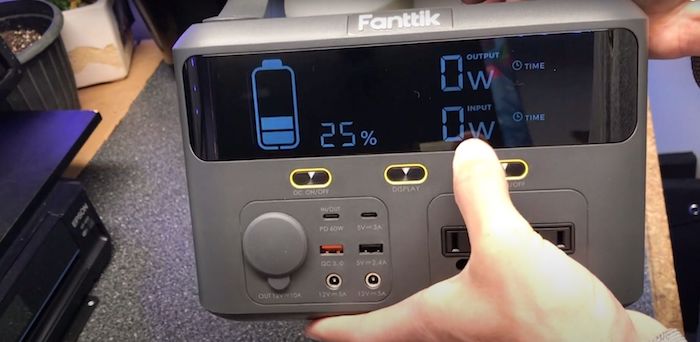
| Model | Fanttik EVO 300 Portable Power Station |
|---|---|
| Battery Capacity | 299Wh |
| Battery Expansion Available? | No |
| AC Ports | x2 - 300W Continuous (600W Surge) |
| USB Ports | x1 USB-A (5V, 2.4A) x1 USB-A QC 3.0 (18W max) x1 USB-C PD (60W max) x1 USB-C (5V, 3A) |
| 12V DC Ports | x1 Car Port (12V, 10A) x2 DC5521 Ports (12V, 5A per port) |
| Recharging Times* | AC Wall Charger (85W avg.): 3.5 hrs USB-C PD + AC Wall Charger (145W): 2.5 hrs Car Charger (80W avg.): 3.7 hrs Solar Charging @ Max Input (120W): 2.5 hrs Solar Charging w/ EVO 100 Panel (80W avg.): 3.7 hrs |
| Battery Cycle Life | Unlisted |
| Comes With | x1 EVO 300 x1 AC Wall Charger x1 Car Charging Cable x1 USB-C to USB-C Cable x1 Accessory Bag |
| Check Price (Affiliate Link) | Amazon |
Output testing
The EVO 300 has nine total output ports:
- x4 USB ports
- x3 12V DC ports
- x2 AC ports
All output ports are located on the front of the power station. They are broken into two sections: on the left side are the DC outputs (12V and USB) and the AC ports on the right.
Each port section is activated by pressing its correlating “DC” or “AC” buttons underneath the LCD screen.
AC ports (300W continuous, 600W surge)
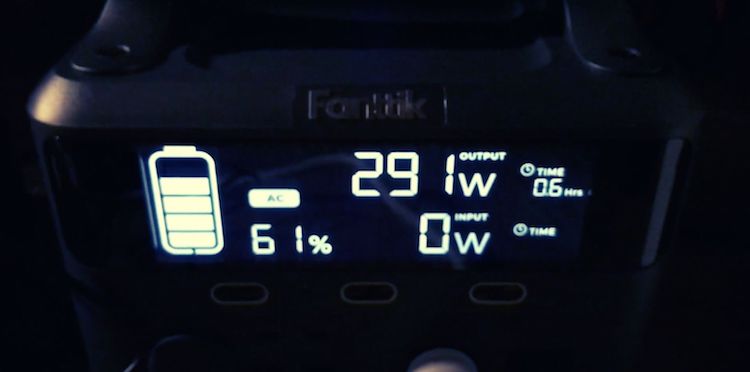
I tested the EVO 300’s AC ports by connecting one port to a power strip and then connecting my appliances/chargers to it.
However, before that test, I tested it with my EcoFlow River Max AC charger. This resulted in an error message after a few seconds, and in the manual, the error code said it was due to a short circuit.
Since it was a risk for me to attempt to charge the River power station from the Fanttik, this error message did not mean that the Fanttik malfunctioned. I was simply using an incompatible device that was drawing too much power.
I then solved the issue by resetting the AC ports.
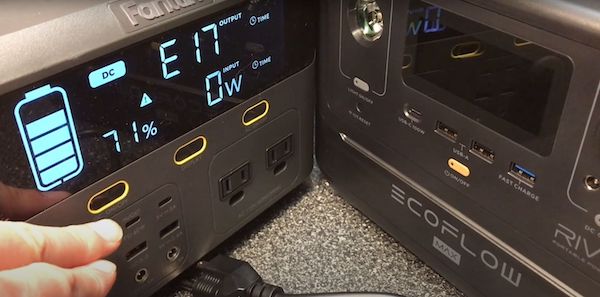
In my second test, I used a power strip to connect my Jackery 1000 and Jackery 300 chargers to it as well as my 32″ LCD TV. The EVO 300 was able to output a continuous 290-295W of power to all of these devices, while also surging in one instance to over 340W.
This showed that the power station could handle its rated power output of 300W continuously.
Throughout this process, the power station did not make a sound from its cooling fans. This was astonishing to me because every single power station I’ve previously tested has made at least some noise when testing its AC ports to their limits. However, the EVO 300 was unphased.
USB-C and USB-A ports (4 total)

Here’s the rundown of the EVO 300’s USB ports:
- x1 USB-A (5V, 2.4A)
- x1 USB-A QC 3.0 (18W max)
- x1 USB-C PD (60W max)
- x1 USB-C (5V, 3A)
I started with the USB-C PD port and connected it to my Sherpa 100AC power bank to charge it from the EVO.
It successfully outputted 56W into the Sherpa, which is a successful charge that nearly hits its 60W rated output. This is typical for 60W USB-C ports, as a couple of watts are lost through the charging cable.
Next was the standard USB-C port, rated at 5V/3A or 15W max. This initially did not charge my power bank, but after moving the USB-C to a second input on the power bank, it successfully charged it up.
The USB-A ports worked easily, both outputting 12W into the Sherpa. My power bank only allows up to 12W from any USB-A output, but the EVO 300 has a QC 3.0 output capable of up to 18W for compatible devices.
12V outputs: car port and DC5521 ports
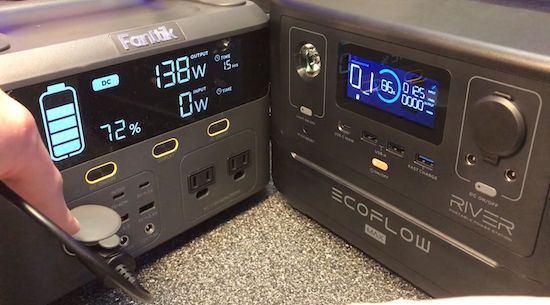
Here are the 12V ports along with their amperages:
- x1 Car Port (12V, 10A)
- x2 DC5521 Ports (12V, 5A per port)
I was surprised to find that the EVO 300’s car port output was regulated. In my test, it was outputting 138W consistently as opposed to its 120W rating in its manual. I used the EVO to charge my EcoFlow power station in the test.
The two DC5521 outputs are capable of 120W combined, but I tested a single output port, which is rated for 60W (12V, 5A). Using this port to charge another power station of mine in the test, the EVO 300 produced 84W.
Overall, both the car port and DC5521 ports worked successfully and exceeded my expectations.
Input testing
I tested solar panel charging, wall charging, car charging, as well as USB-C plus AC charging methods. The fastest charging method is from USB-C and AC combined charging (about 140-150W).
AC, car, and solar charging all use similar amounts of power to charge the EVO up (between about 75-85W).
Solar panel charging
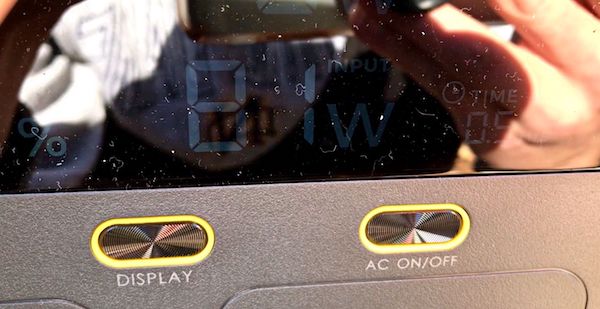
On a sunny day in 50-degree weather, I used the EVO 100 solar panel (rated at 100W) to charge the power station. I first tested it on the ground with its kickstand out and received 50-60W of power.
I noticed that the towels I placed under the panel were blocking some of the solar cells, so I took the panel off the ground and placed it on a bench to make sure it had full exposure. In this setting, the panel produced a maximum of about 81W and maintained a consistent 70-80W output.
After filming this, I concluded that the panel output power was above average since it showed that it had at least an 80% efficiency.
The EVO power station also has an MPPT charge controller, which promotes an efficient solar charging process.
AC & USB-C PD charging
Using just the AC wall charger, I was receiving about 85W of power consistently into the EVO 300. This was very close to the 90W rating on the wall charger.
After this, I added a USB-C PD charger to work simultaneously with the AC charger. I recorded about 142W of consistent input into the EVO 300.
At this rate, the power station would be able to fully charge from 0-100% battery in just over two hours.
Car charging
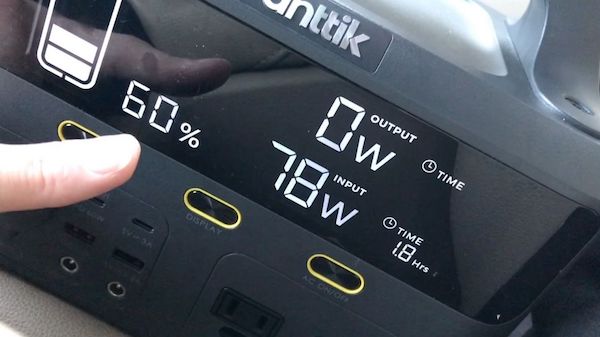
Using the included car charger, I recorded 78-80W of input from my car’s 12V port. However, there were two instances where the wattage decreased to about 40-45W and then picked back up to about 80W. I’m not sure why this happened, but I concluded that it was a successful test since the power consistently returned back to about 80W.
The car charger, unlike the solar panel, connects to the power station via a DC7909 input, which is on the back of the EVO 300 and right next to the Anderson Powerpole input.
Unique features of the EVO 300 power station
- Anderson Powerpole Input: Several solar panels that are paired with power stations have proprietary input ports for solar charging. This means that you can’t use a third-party panel without buying an adapter. An Anderson input allows you to use several different types of solar panels if you want to.
- Large LCD Screen: The Fanttik clearly has one of the largest LCD screens I’ve ever seen – in person as well as online. It spans the entire width of the power station and can be read easily.
- LED Floodlight: Although it isn’t all that uncommon, the Fanttik power station has a very bright LED lamp located near the input ports on the rear of the system. It has three modes: 50% brightness, full brightness, and S.O.S. mode.
- Silent: As I stated in my YouTube review of the EVO 300, it didn’t make a single noise throughout my entire testing process. This is uncommon for any power station of this size.
Fanttik EVO Solar 100 solar panel (100W)
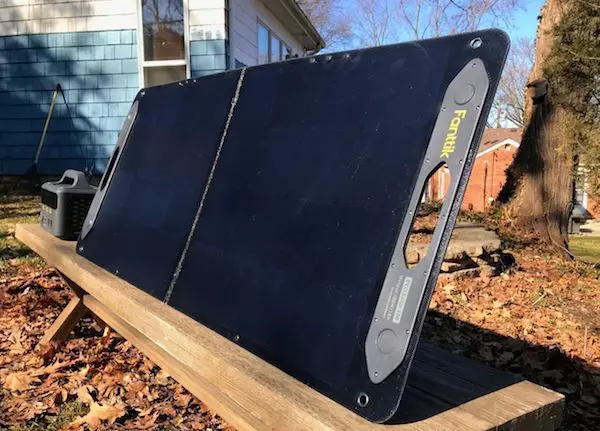
The solar panel meant for the EVO power station has several features that stood out to me when analyzing and testing it.
First and foremost, it has the output of a quality solar panel, at 80W in good sunlight. This is by far the most important characteristic of the panel, but it has some additional subtle features that set it apart from other models found with similar power stations, including:
- Magnetic open/close: Near the handle of the panel lie two large magnets that hold it in a closed position when storing or transporting it.
- Magnetic kickstand: Similar to the open/close mechanism, each kickstand is held closed with small magnets.
- Supported kickstand: This feature is not common in solar panels of this kind. There are a series of bands that connect the legs/kickstand to the panel, making it easy to adjust the panel’s angle.
The supported kickstand is one of my favorite features of this panel. In my experience, the slightest change in angle can significantly alter the output of the panel. The bands in the EVO Solar 100 make it easier to make small angle adjustments to maximize output.
Pros and cons of the EVO Solar 100
| Pros | Cons |
|---|---|
| 1. Received about 80W in testing – High output for its size (80% efficiency) | 1. Folds only once over, making it mainly ideal for short-distance carry only |
| 2. Easy to maneuver with unique kickstand supports | 2. The panel size (100W) produces only about 70% of the EVO 300’s 120W max input |
| 3. Rated at IP65 (resistant to dust and water) | 3. Heavy (10.8 lbs) for a 100W portable solar panel |
Although its pros heavily outweigh its cons overall, the main downside is that the panel folds over just once, making it bulky to carry. Several solar panels on the market share this design, but the ideal layout for portability is to have the panels fold 3-4 times over.
For example, my 120W Elecaenta solar panel has a higher output rating than the EVO 100, but it folds over four times and is about half the size of the EVO panel when folded. This makes it much easier to carry around and store.
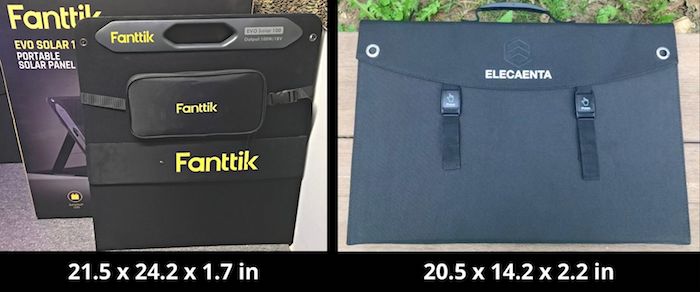
If you want a solar panel with more portability than the Fanttik panel, I recommend reading my review of the Elecaenta solar panel here: ELECAENTA 120W Foldable Solar Panel Review (Testing & Comparison). This panel works with the EVO 300 as it has an Anderson Powerpole and DC7909 output.
Fanttik EVO Solar Generator vs. Similar Kits
Below I have a table comparing popular 300Wh solar generator systems (power station plus solar panel). The solar panels are between 100-110W and power stations are between 280-300Wh in battery capacity.
I’ll be directly comparing each power station and solar panel after.
| Brand | Fanttik | EcoFlow | Jackery | Rockpals |
|---|---|---|---|---|
| Kit Includes | 1x EVO 300 power station 1x EVO 100 solar panel | 1x River 600 power station 1x EcoFlow 110W solar panel | 1x Explorer 300 power station 1x SolarSaga 100 solar panel | 1x Rockpower 300 power station 1x Rockpals 100W solar panel |
| Price (Subject to Change) | $580-620 | $550-700 | $600 | $416-430 |
| Compare Pricing | Amazon | 1. Amazon 2. Shop Solar Kits 3. EcoFlow's site | 1. Amazon 2. Jackery's site | 1. Amazon 2. Rockpals Website |
As you can see, the Rockpals solar generator kit is much cheaper than the other kits. The Fanttik kit is in the middle in terms of price, right alongside the Jackery 300 kit. The EcoFlow system averages higher than the others’ pricing, but not drastically higher.
To make things easier, I broke down the specifications and features of each power station from the kits listed above. Each model has its own unique characteristics, but all of them contain a lithium-ion battery type.
Portable Power Stations Compared
| Model | Fanttik EVO 300 | EcoFlow River 600 | Jackery Explorer 300 | Rockpals Rockpower 300 |
|---|---|---|---|---|
| Battery Capacity | 299Wh | 288Wh | 293Wh | 280Wh |
| AC Ports | x2 - 300W continuous (600W surge) | x3 - 600W continuous (1,200W surge) | x2 - 300W continuous (500W surge) | x1 - 300W continuous (500W surge) |
| USB Ports | x1 USB-A (5V, 2.4A) x1 USB-A QC 3.0 (18W max) x1 USB-C (5V, 3A) x1 USB-C PD (60W max) | x2 USB-A (5V, 2.4A) x1 USB-A Fast Charge (18W max) x1 USB-C (100W max) | x1 USB-A (5V, 2.4A) x1 USB-A QC 3.0 (18W max) x1 USB-C PD (60W max) | x2 USB-A (5V, 3.1A) x1 USB-A QC (18W max) x1 USB-C PD (30W max) |
| 12V DC Ports | x1 Car Port Output (12V, 10A) x2 DC5521 Ports (12V, 5A per port) | x1 Car Port Output (13.6V, 10A) x2 DC5521 Ports (13.6V, 3A per port) | x1 Car Port Output (12V, 10A) | x1 Car Port Output (12V, 10A) x2 DC5521 Ports (12V, 5A per port) |
| Max Solar Input | 120W | 200W | 90W | 72W |
| Recharging Times (0-100%) | AC Wall Charger: 4 hrs USB-C PD + AC Wall Charging: 2.5 hrs 100W Solar Panel: 3.5-6 hrs Car Charger: 4 hrs USB-C PD: 5.5 hrs | AC Wall Charger: 1.6 hrs 110W Solar Panel: 3-6 hrs Car Charger: 3.5 hrs | AC Wall Charger: 4.5 hrs USB-C PD + AC Wall Charging: 2.5 hrs 100W Solar Panel: 4-5 hrs Car Charger: 5 hrs USB-C PD: 5.5 hrs | AC Wall Charger: 4.5-5.5 hrs USB-C PD + AC Wall Charging: 3-4 hrs 100W Solar Panel: 4.5-6.5 hrs Car Charger: 6-7 hrs USB-C PD: 9-10 hrs |
| Weight | 8.8 lbs | 11 lbs | 7.1 lbs | 7.7 lbs |
| Battery Lifecycles | Not listed | 500 cycles to 80% capacity | 500 cycles to 80% capacity | 500 cycles to 80% capacity |
| Comes With | x1 Wall Charger x1 Car Charger x1 USB-C to USB-C Cable x1 Accessory Bag | x1 Wall Charger x1 MC4 to XT60 Cable x1 Car Charger x1 DC5521-DC5525 Cable | x1 Wall Charger x1 Car Charger | x1 Wall Charger x1 Car Charger |
Although the battery capacity of these power stations is similar, the output ports and input ports of each model clearly distinguish their capabilities.
Output port differences
- The EcoFlow River has the most output port options of the four, with ten total, but the Fanttik has just one less AC port.
- The biggest difference is the EcoFlow’s AC output power, which is double that of the others, at 600W continuous and 1,200W surge.
- The Fanttik power station has the most variety when it comes to USB options, and its 12V DC ports are similar to the Rockpals 300 model, except the Rockpals 300’s 12V ports aren’t regulated, whereas the Fanttik’s 12V ports are regulated.
- As for the runner-up in AC output power, the Fanttik takes second place since its surge capabilities are 100W higher than the Jackery and Rockpals models.
Input power – differences explained
Input power is vital to make sure the power station can recharge in ample time.
- The Rockpals 300 has the slowest recharging times since its wall charger, car charger, and USB-C PD ports have lower wattage capabilities than the others.
- The EcoFlow River has a 200W maximum solar input, which is nearly three times greater than the Rockpals 300’s 72W max input and over two times higher than the Jackery 300’s input.
- The Fanttik EVO 300 splits the difference, with a substantial 120W max solar input.
For solar charging, the power station’s maximum solar input should be used to decide on the solar panel (or panels) you intend to pair it with. Below I have each solar panel associated with the power stations above along with most of their specifications.
Comparing Solar Panels (100-110W)
| Solar Panel Model | Fanttik EVO Solar 100 | EcoFlow 110W Panel | Jackery SolarSaga 100 | Rockpals SP003 100W |
|---|---|---|---|---|
| Wattage | 100W | 110W | 100W | 100W |
| Outputs | x1 Anderson Powerpole | x1 MC4 | x1 USB-A, x1 USB-C, x1 Jackery DC Output | x1 USB-A, x1 USB-C QC3.0, x1 MC4 |
| Dimensions (folded) | 21.5 x 24.2 x 1.7 in | 16.5 × 20.2 × 1 in | 24 x 21.1 x 1.4 in | 20.5 x 14.2 x 2.6 in |
| Dimensions (unfolded) | 48.6 x 21.5 x 1 in | 62.5 × 20.2 × 1 in | 48 x 21.1 x 0.2 in | 64.5 x 20.5 x 1.2 in |
| Weight | 10.8 lbs | 13.2 lbs | 5.5 lbs | 5.1 lbs |
| IP Rating | IP65 | IP67 | IP65 | IPX4 |
| Warranty | 24 Months | 12 Months | 24 Months | 12 Months |
| Additional Features | Reinforced kickstand, grommets, magnetic open/close, carrying handle, removable accessory case | Adjustable kickstand, grommets, rubber handle, carrying case, compact design | Adjustable kickstand, grommets, magnetic open/close, carrying handle, zippered pouch | Comes with adapters for charging different power stations, grommets, carrying handle, zippered pouch |
Although I can only speak on behalf of the EVO Solar 100 panel in terms of efficiency/output, I highly recommend checking out Amazon and YouTube reviews of these solar panels for first-hand feedback regarding their true output power.
Using the data in the table above, there are features in addition to solar panel output that may come into play for you when deciding on which is the best value for your money.
Output ports
Jackery’s SolarSaga 100 and the Rockpals panel share USB port options in addition to their main DC connection. This can be an advantage if you need the additional ports, but since the power stations have their own USB ports, this feature seems unnecessary.
However, the positive side of having these ports means that you can charge a device from USB without a portable power station if desired.
Folded/unfolded dimensions
- The Jackery and Fanttik panels share similar dimensions, while the Rockpals and EcoFlow panels share similar measurements.
- The Rockpals and EcoFlow models are more portable since they fold four times over instead of two.
Weight
- The EcoFlow 110W model is the heaviest at 13.2 lbs, then Fanttik’s panel at 10.8 lbs. The Jackery and Rockpals panels are extremely light at just over five pounds each.
- The weight of each panel combined with its folded dimensions is crucial if you’re looking to be as mobile as possible. If we consider these factors, then the Rockpals panel is the most portable option of the four.
Water resistance rating
In the IP grading scale, the higher the last number, the more water-resistant it is.
- The solar panel with the highest water resistance is the EcoFlow panel. Its IP67 rating means that it can actually be submersed underwater for up to 30 minutes without any damage.
- Jackery and Fanttik share the IP65 rating, which means they can be sprayed with water from all directions without damage.
- In last place is the Rockpals SP003 panel with an IPX4 rating. This rating means that it can withstand splashes of water from any direction.
Disclaimer: I don’t recommend using your solar panels when it’s wet or raining outside. This risks exposing electrical components to water, which can damage the panel and risk shock. I do recommend making sure all exposed ports and cables on the panel are packed away and/or covered if you do find yourself in the rain, though.
Additional features
- The Rockpals panel doesn’t have a kickstand but the rest of the models do.
- The Fanttik solar panel has the best kickstand setup because its two legs are assisted with flexible bands. The Jackery panel doesn’t have this feature. The EcoFlow panel uses its own carrying case as a kickstand, but it only supports the two middle panels, leaving the two outside panels to be somewhat flimsy.
- All of the panels have grommets and carrying handles, and three of them have zippered pouches for cable storage. The EcoFlow model doesn’t have this, but instead it has a storage bag for the entire panel.
Which kit is best?
Check out the table below for my ranking of each solar generator kit. I did my best to factor in every single aspect of these kits, but keep in mind that one system may have specific features that you value more than others.
Point scale (for each category):
- 1st = 4 points
- 2nd = 3 points
- 3rd = 2 points
- 4th = 1 point
| Solar Generator Brand | Fanttik | EcoFlow | Jackery | Rockpals |
|---|---|---|---|---|
| Portability | 4th | 3rd | 2nd | 1st |
| AC Output Power | 2nd | 1st | Tied 3rd | Tied 3rd |
| Recharging Speed | 2nd | 1st | 3rd | 4th |
| Quality Port Options | Tied 1st | Tied 1st | 3rd | 4th |
| Unique & Useful Features | 2nd | 1st | 4th | 3rd |
| Average Price | Tied 2nd | 3rd | Tied 2nd | 1st |
| Overall | 2nd Place (17 points) | 1st Place (20 points) | 4th Place (13 points) | 3rd Place (14 points) |
The EcoFlow River with its 110W solar panel is the best kit of the four. It won by a slim margin over the Fanttik EVO 300 kit. The EcoFlow kit has the best AC output, the fastest recharging speeds, and the most unique features.
- The EcoFlow River has the ability to expand its battery size. It can double its battery to 576Wh with an optional upgrade. The battery connects to the bottom of the power station, effectively turning it into the River Max power station.
- The River also has its own application that pairs with your smartphone.
I have the River Max and wrote a thorough review of it to test its power. You can read it here: EcoFlow River 600 Review – Testing My River Max + Comparisons.
Obviously, my ranking of these solar generators is not set in stone because one might be better for your own needs. For example, the Jackery or Rockpals solar generators are much lighter than the EcoFlow and Fanttik kits (about 8-12 lbs lighter).
If portability is your main ranking factor, then the Rockpals kit may be the best option because its power station and solar panel are lightweight; plus, the Rockpals solar panel folds to a much more compact frame than the Jackery model so you can easily carry it around.
The Fanttik solar panel has excellent qualities, but the two areas where it lacks are in its weight and folded dimensions.
Even though the Fanttik kit is over four pounds lighter than the EcoFlow kit, the EcoFlow panel is more collapsible, which makes it more portable.
My closing thoughts & recommendations

Overall, the Fanttik solar generator is made with high-quality components and performs very well for a small portable system. Ultimately, this system surprised me by how well-made it is. This is Fanttik’s first-ever solar generator and I was skeptical about how it would perform. However, there are several elements that work very well with this system.
- The EVO Solar 100 panel has an impressive output, is easy to maneuver into position, and its magnetic open/close features are top-notch.
- The EVO 300 has easily the largest screen for its size, a bright LED floodlight, and each one of its input and output ports work to their specifications (the 12V outputs actually exceeded their specifications).
- I was most impressed by how quiet this power station was during testing. It didn’t make a single noise when using it to charge or discharge (even at full AC output).
You can find all of my testing of the power station in my YouTube review below.
You can find the EVO 300 as well as the EVO Solar 100 panel on Amazon below. These are affiliate links, where I make a small commission with each sale.








